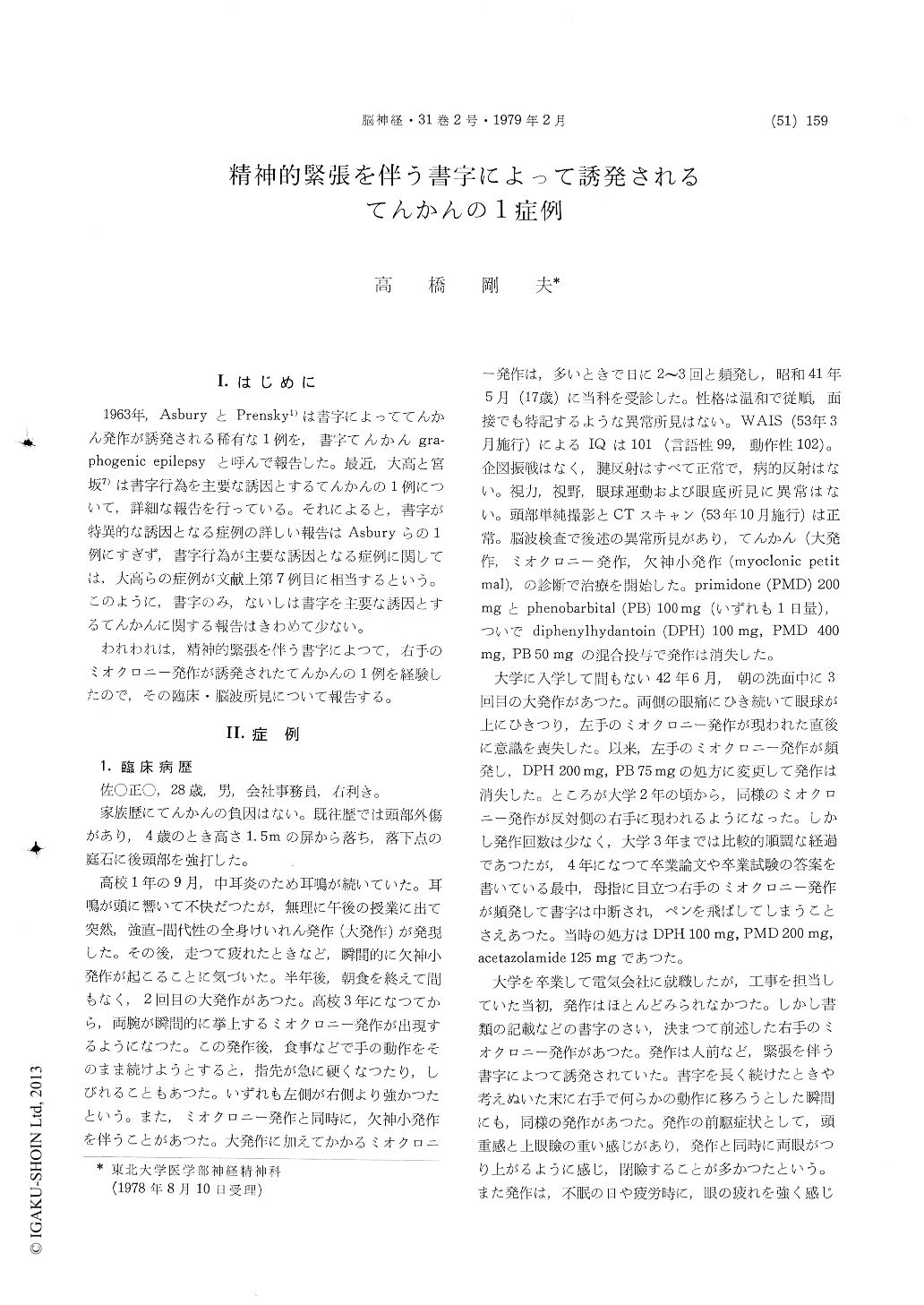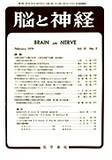Japanese
English
- 有料閲覧
- Abstract 文献概要
- 1ページ目 Look Inside
I.はじめに
1963年,AsburyとPrensky1)は書字によっててんかん発作が誘発される稀有な1例を,書字てんかんgra—phogenic epilepsyと呼んで報告した。最近,大高と宮坂7)は書字行為を主要な誘因とするてんかんの1例について,詳細な報告を行っている。それによると,書字が特異的な誘因となる症例の詳しい報告はAsburyらの1例にすぎず,書字行為が主要な誘因となる症例に関しては,大高らの症例が文献上第7例目に相当するという。このように,書字のみ,ないしは書字を主要な誘因とするてんかんに関する報告はきわめて少ない。
われわれは,精神的緊張を伴う書字によつて,右手のミオクロニー発作が誘発されたてんかんの1例を経験したので,その臨床・脳波所見について報告する。
This 28-year-old right handed office-worker had a past history of head trauma at the age of 4. At the age of 16, he had his first grand mal seizure. Since then he has had recurrent myoclonic jerks of both hands (more over the left than the right), often associated with petit mal absence. He was first seen in our clinic at the age of 17, when neurological examination was negative. On EEG examination, the basic rhythm was 7.5 to 8 Hz, and generalized paroxysmal discharges were seen while awake and during hyperventilation. Since then he has been given anticonvulsants. From the age of 20, myoclonic jerks, which are particulary strong at thumb, have shifted to the right hand. At the age of 22, when he was busy in writing a thesis, the myoclonic jerks appeared frequently. Since graduation from a college of technology, hehas been employed as an office-worker. In spite of taking anticonvulsants (diphenylhydantoin 100 mg, primidone 200 mg and acetazolamide 125 mg per day), myoclonic jerks have appeared frequently, especially when writing in the presence of others. EEGs recorded at the ages of 21, 25 and 26 showed bilateral paroxysmal discharges over both central-parietal-frontal areas only in sleep.
At the age of 27, precise EEG examination was carried out because of frequent seizures which made him depressed. Ciphering with either the right or left hand provoked bilateral paroxysmal discharges, maximal over both central areas with focal accentuation over the left central area. They appeared both at the beginning of and during ciphering. In addition to ciphering, writing "KANJI"(the Chinese characters) and writing a composition provoked similar paroxysmal discharges. Movements of both hands and feet, however, did not provoke paroxysmal discharges. The mechanical movements of the right hand, such as using an abacus with the right thumb and index finger, were also ineffective. No paroxysmal discharges were induced by various methods of EEG activation including mental calculation, eyes closing and opening, eyes deviation, various visual stimuli, odorous, auditory and somatosensory stimuli and hyperventilation. In addition, constructing complete sentences in his mind, conversation, reading aloud, copying letters and writing sentences with" KANA" and" HIRAGANA"(the two sets of Japanese phonetic symbols) failed to provoke paroxysmal discharges.
From the above findings, it was suggested that the writing associated with psychic tension consti-tuted the most important factor for inducing myo-clonic seizure of the right hand. It was also thought that the epileptic focus in the Exner's writing center (possibly"mirror focus"to the right central area) was activated by writing ; simultaneous ex-citatory effects from the subcortical regions, such as the corpus callosum, as well as the reticular formation influenced by psychic tension might perhaps have further activated the cortical focus, which then developed into clinical seizures.
Finally, it should also be noted that no clinical seizures have been seen for more than 2 years since the beginning of treatment with diazepam (6 mg per day) in addition to the previous anticonvulsants.

Copyright © 1979, Igaku-Shoin Ltd. All rights reserved.


